Hyaluronic Acid Fillers (Restylane / Juvederm)
The cosmetic physicians have been looking for an injectable substance to fill up or augment the soft tissue in the skin. The ideal substance should be non-toxic, does not cause allergic or inflammatory reactions, is stable after injection, will not lose easily but can be reabsorbed.
Different injectable cosmetic fillers have been used to replace the lost matrix volume by injecting into the dermis. There are many types, the earliest kind was probably collagen derived from animals. Now the most popular dermal filler is Hyaluronic Acid. There are many different brands including Restylane, Juvederm, and Hylaform.
What Is Hyaluronic Acid?
Hyaluronic acid is a natural complex sugar formed by Glucosamine and Glucuronic acid. It is found in all living cells, and its basic structure is the same in different species. It retains water like a sponge, absorbing more than 1000 times its weight, and forms a highly concentrated gel material.
It is a major component of the dermis connective tissue matrix, along with collagen and elastin. Its property helps to attract hydration and maintain volume in the skin. If the collagen and elastin are the steels rods, then the hyaluronic acid and water in the dermal matrix is the cement concrete.
As we age, apart from the loss of collagen and elastin in the dermis, the support dermal matrix also loses its volume. As a result, the natural volume of youthful skin begins to diminish, and wrinkles and folds form.
How Does It Work?
It is very simple. After being injected into the dermis, it absorbs and retains water, and the expansion will enhance the volume. It is slowly broken down into carbon dioxide and water in the liver. Special preparations are needed to increase its stability and slow this down, so that the cosmetic effect will be longer lasting.
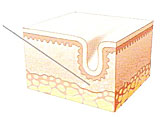 |
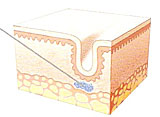 |
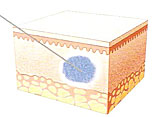 |
Lots of people get confused between hyaluronic acid dermal fillers and Botox. The filler fills in wrinkles, furrows, and enhances lips. Botox relaxes underlying muscles that produce frown lines, forehead wrinkles, crow’s feet, lip lines, chin dimpling, and neck banding.
Common uses include:
- Reduce wrinkles like worry lines, smile lines, crow's feet
- Reduce marionette lines at corners of the mouth, and smoker's lines
- Reduce nasolabial folds (folds between corners of nose and corners of mouth)
- Fill up cheek depressions caused by fat loss
- Fill up hollows under the eyes, at back of the hands
- Soften depressed scars
- Nose-bridge enhancement
- Lips enhancement
- Chin augmentation
There are different concentrations as well as particle sizes for applications in different areas. If injection is made in a deeper level of the dermis, then a larger particle size is chosen to avoid too early re-absorption.
Here are some examples of the treatments:
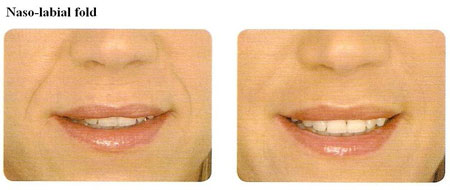
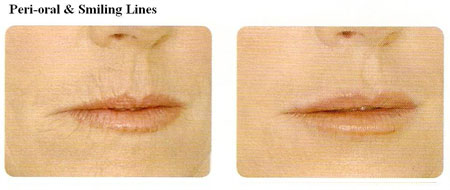
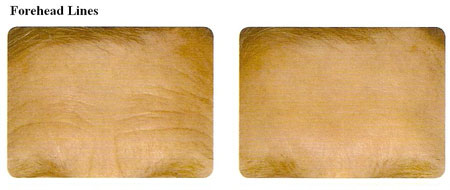
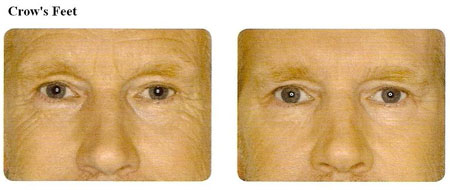
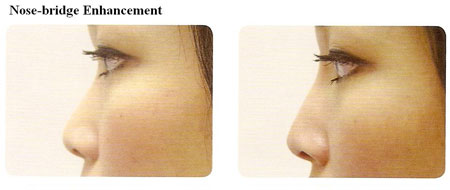
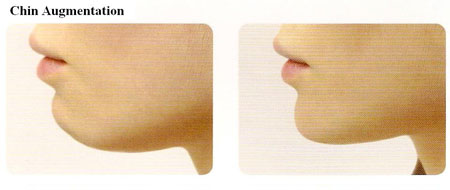
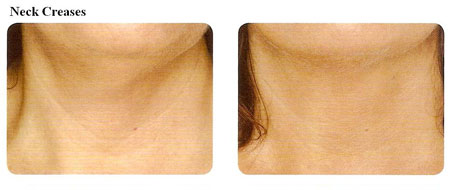
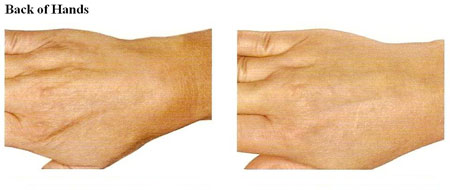
How Is It Done?
Because hyaluronic acid dermal fillers are non-animal-based, they can be administered without pre-testing. (Unlike bovine collagen, which is derived from animals, i.e. cow, and requires an allergy test.)
The volume of gel injected is actually very small, ranging from 0.4cc to 1.0cc. This is done using an ultra-fine needle. There is some pain but usually well tolerable and the doctor may apply a local anaesthetic cream on the area for an hour prior to the injection.
How Long Does It Last?
The result is immediately noticeable. Often the wrinkle or fold will be diminished by 50 - 80%, or more, depending on the severity and the amount of filler used. The result will usually last for 6 - 9 months. As the filler is slowly re-absorbed, the enhanced volume will shrink gradually. After that, it needs to be repeated again.
Hyaluronic acid dermal fillers are proven to deliver a longer-lasting effect than traditional bovine collagen.
What Are The Side Effects?
After injection, the area may appear a little red and swollen, but this is usually very transient. Occasional it may cause a bruise, which will last for a few days. Those taking aspirin have a higher chance of a bruise.
There are reports of an immediate and a delayed type hypersensitivity reactions. This may be related to uses of products from lesser-known companies in some countries, and may be due to impurities during the preparation process. It is better stick to the more researched and approved products.
Sculptra (PLLA)
We have looked into the Hyaluronic acid fillers, which work mainly by absorbing water and hold up a volume. There has been another class of filler on the market since 1999, and has just been launched in Hong Kong in 2010.
This filler compose of poly-L-Lactic acid (PLLA). Currently the only brand available is Sculptra.
What Is Sculptra - PLLA?
PLLA is a synthetic but biocompatible, biodegradable material that has been used in surgical resorbable stitches for decades. It is the main ingredient in Sculptra, and is now a new type of facial injectable which helps to replace lost collagen.
How Does Sculptra Work?
Collagen is a key structural component that keeps skin looking youthful and smooth. As you age, your body's collagen production decreases, and you may begin to see wrinkles. Sculptra works to replace lost collagen in the deep dermis in a series of treatments, and correct shallow to deep facial wrinkles and folds, by stimulating the natural production of collagen, and this results in a refined, more youthful looking appearance.
Sculptra is very different because it gradually and subtly corrects these facial wrinkles. This can provide a refined, more youthful looking appearance that can last up to two years.
Sculptra is most suitable for people who do not want a sudden, too much improvement in an instant. Hence your friends and relatives may not notice that you have something done except that you appear younger and younger over the next few months.
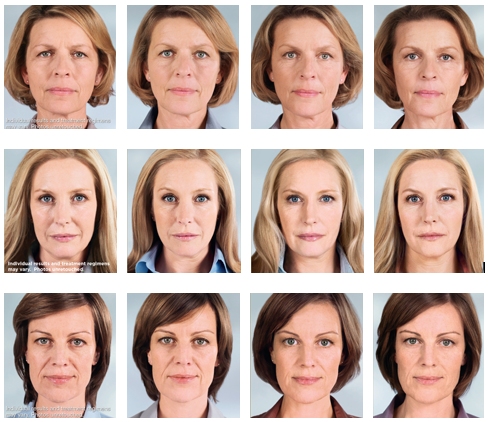 |
|||
| Before treatment | After 1 session | After 3 sessions | 20 months later |
How Does Sculptra Work?
Sculptra is for use in people as one-time treatment regimen of up to 4 injection sessions that are scheduled about 3 – 4 weeks apart. No allergy testing is required prior to treatment as Sculptra is biocompatible. Sculptra is injected into the deep dermis and subcutis layer, and is suitable for :
- Deep folds between the nose and the mouth (nasolabial folds)
- The lines framing your mouth (marionette lines)
- Cheek wrinkles
- Temples
- Sunken cheeks
- Tear Trough
- In fact any area that display a loss of volume
On average, three injection sessions are needed over a few months, but your doctor will tailor the sessions to best suit your desired outcome. It is important to return for all sessions in order to get the maximum effect from the gradual process of collagen replacement.
In each session, the number of injections will vary depending on the degree of correction that is right for you. Your doctor may use a topical anesthetic cream and you may experience injection site discomfort in the treatment process.
Immediately after you may experience some swelling. This is a preview of how you may look once your facial wrinkles and folds have been smoothed. This swelling on average subsides within a few days and the wrinkles will temporarily reappear as the gradual process of collagen replacement continues. You may begin to see progressive visible results within the first few weeks after each treatment session.
During the course of treatment, your physician may adjust your treatment plan to help you reveal a natural-looking appearance that's uniquely yours. However, individual results and treatment sessions may vary from person to person.
Normal activities can be resumed immediately; however, you are advised to stay out of the sun. You should massage the area for a few times a day for 3 days or so, this will help promote even distribution of Sculptra.
How Does Sculptra Work?
Following an average of three treatment sessions, 4-6 vials of Sculptra, over a few months, clinical studies have shown that the results can last for two years after the final treatment has been completed, significantly longer than other injectables such as collagen and hyaluronic acid. After that you can do a touch up, when only 1 vial of Sculptra is necessary to maintain the good natural look.
What Are The Side Effects?
Side effects may include injection site discomfort, pain, redness, bruising, swelling, and/or itching that may last for a few days.
Small bumps and larger lumps under the skin in the treated area may appear but these typically go away on their own without treatment, although very rarely some may require a small injection with steroid.
Our Unique Injection Technique
Most doctors use a short needle to inject the Sculptra. This would require multiple injections up to 15 to 20 jabs on each side of the face. The problems with that is:
- You need numbing cream for 30 to 60 minutes before the procedure.
- It is still rather painful with that many injections.
- It is very likely to cause bruising and swelling afterwards.
- It is more likely to cause lumps in the skin.
At DrHB Clinic, ever from our first patient, we use a longer injection tool called the cannula. The doctor only need to numb two small areas on each side of the face by injecting a drop of local anaesthetic. Through these 2 small areas, a slightly bigger needle is used to pierce a hole and through these two little holes the cannula is inserted underneath the skin, when Scuptra is injected. This cannula technique can reach most part of the facial area that need enhancement. Advantages are:
- No need for numbing cream.
- Only two injections on each side of the face. It is relatively painless and may be just slightly uncomfortable.
- It causes no bruising in most cases. In 1 year, we had injected over 100 vials for 30 people, and yet only 2 cases of bruising.
- It is much less likely to cause lumps in the skin. We had only 1 palpable (not visible) single nodule so far.
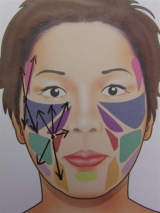 |
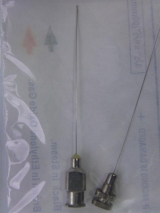 |
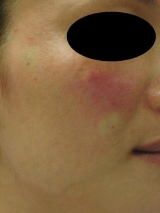 |
| Illustration of Injection | Cannula | Immediate after injection with no bruises or swelling |

